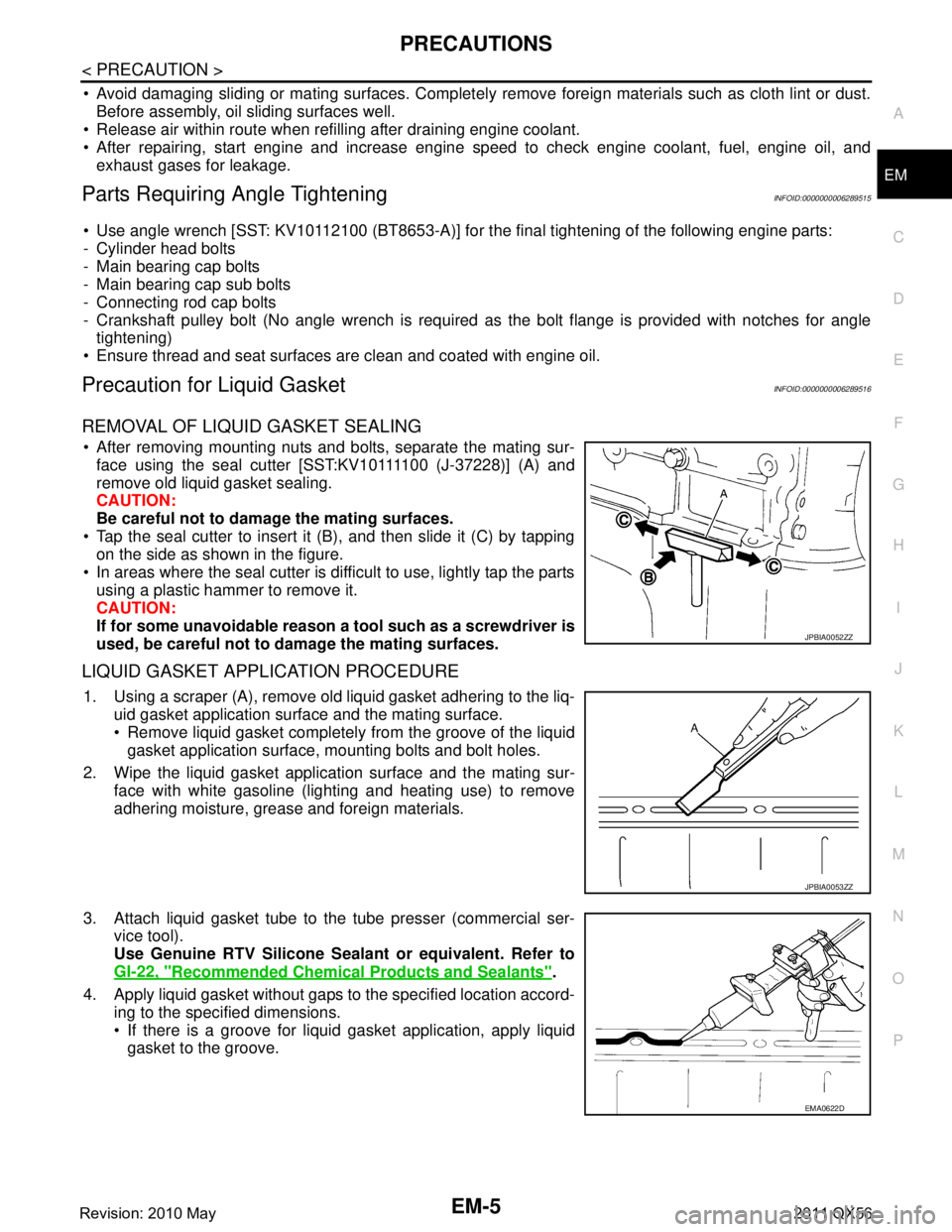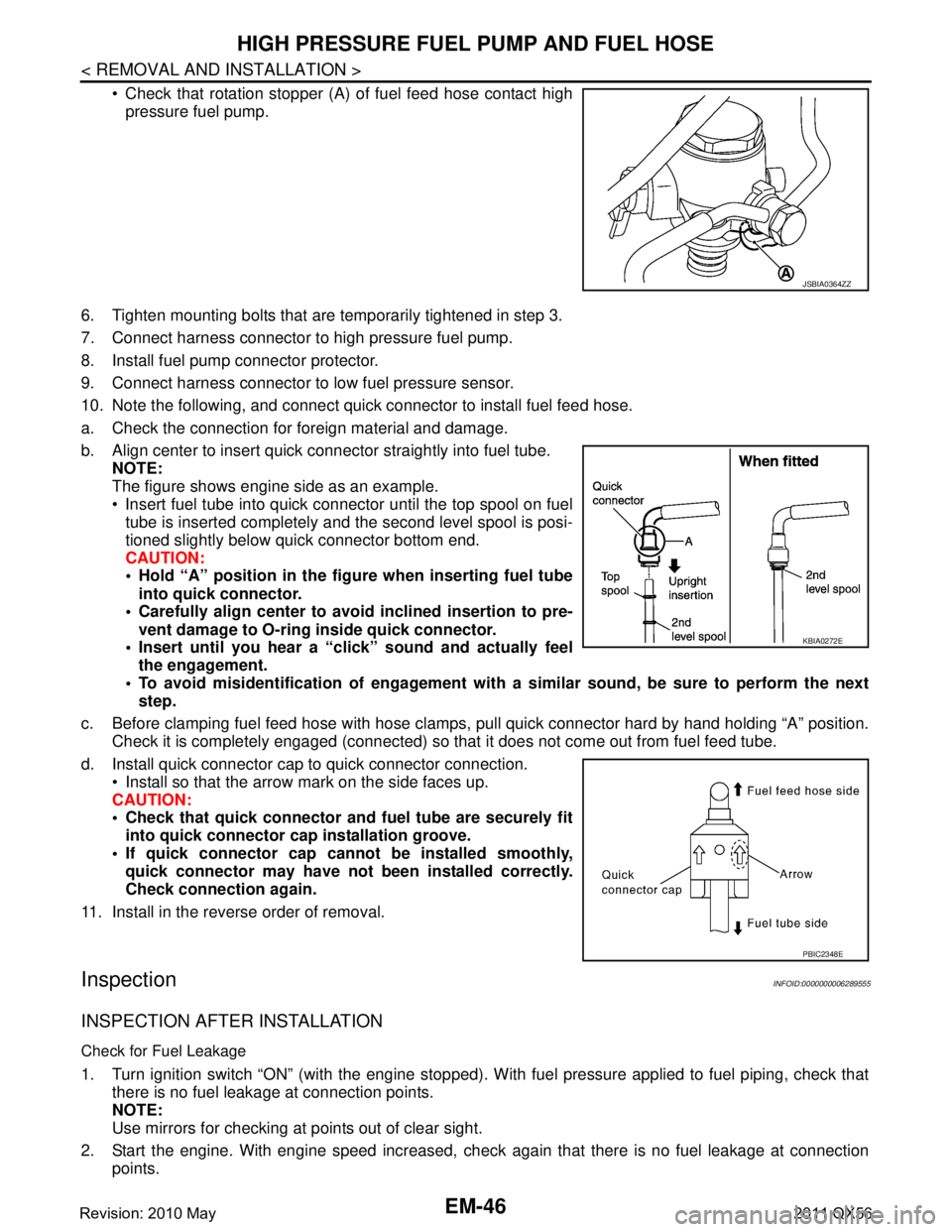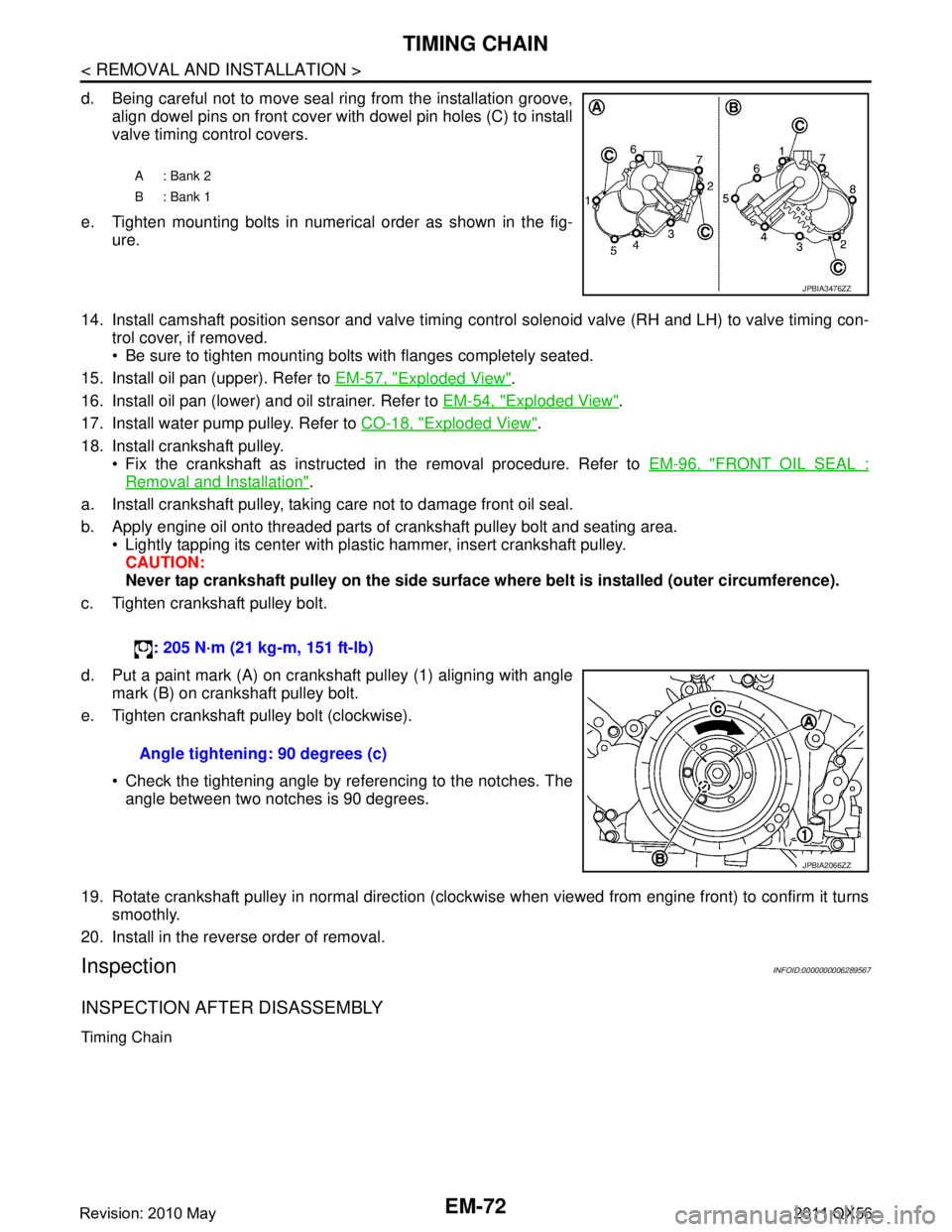2011 INFINITI QX56 light
[x] Cancel search: lightPage 2528 of 5598
![INFINITI QX56 2011 Factory Service Manual
EC-504
< DTC/CIRCUIT DIAGNOSIS >[VK56VD]
ICC BRAKE SWITCH
Is the inspection result normal?
YES >> INSPECTION END
NO >> GO TO 3.
3.CHECK ICC BRAKE SWITCH POWER SUPPLY CIRCUIT-I
1. Turn ignition switch INFINITI QX56 2011 Factory Service Manual
EC-504
< DTC/CIRCUIT DIAGNOSIS >[VK56VD]
ICC BRAKE SWITCH
Is the inspection result normal?
YES >> INSPECTION END
NO >> GO TO 3.
3.CHECK ICC BRAKE SWITCH POWER SUPPLY CIRCUIT-I
1. Turn ignition switch](/manual-img/42/57033/w960_57033-2527.png)
EC-504
< DTC/CIRCUIT DIAGNOSIS >[VK56VD]
ICC BRAKE SWITCH
Is the inspection result normal?
YES >> INSPECTION END
NO >> GO TO 3.
3.CHECK ICC BRAKE SWITCH POWER SUPPLY CIRCUIT-I
1. Turn ignition switch OFF.
2. Disconnect ICC brake switch harness connector.
3. Turn ignition switch ON.
4. Check the voltage between ICC brake switch harness connector and ground.
Is the inspection result normal?
YES >> GO TO 7.
NO >> GO TO 4.
4.CHECK ICC BRAKE SWITCH POWER SUPPLY CIRCUIT-II
Check the voltage between ICC brake switch harness connector and ground.
Is the inspection result normal?
YES >> GO TO 6.
NO >> GO TO 5.
5.DETECT MALFUNCTIONING PART
Check the following.
Fuse block (J/B) connector E103
10 A fuse (No. 3)
Harness for open or short between ICC brake switch and fuse
>> Repair open circuit or short to ground in harness or connectors.
6.CHECK ICC BRAKE SWITCH
Refer to EC-445, "
Component Inspection (ICC Brake Switch)".
Is the inspection result normal?
YES >> GO TO 9.
NO >> Replace ICC brake switch. Refer to BR-20, "
Removal and Installation".
7.CHECK ICC BRAKE SWITCH INPUT SIGNAL CIRCUIT FOR OPEN AND SHORT
1. Turn ignition switch OFF.
2. Disconnect ECM harness connector.
3. Check the continuity between ICC brake s witch harness connector and ECM harness connector.
ECM
Condition Voltage (V)
Connector +–
Te r m i n a l Te r m i n a l
E80 147
(ICC brake switch signal) 175 Brake pedalSlightly depressed Approx. 0
Fully released Battery voltage
ICC brake switch
Ground Voltage
Connector Terminal
E68 2 Ground Battery voltage
ICC brake switch Ground Voltage
Connector Terminal
E68 1 Ground Battery voltage
Revision: 2010 May2011 QX56
Page 2529 of 5598
![INFINITI QX56 2011 Factory Service Manual
ICC BRAKE SWITCHEC-505
< DTC/CIRCUIT DIAGNOSIS > [VK56VD]
C
D
E
F
G H
I
J
K L
M A
EC
NP
O
4. Also check harness for short to ground and short to power.
Is the inspection result normal?
YES >> GO TO 9 INFINITI QX56 2011 Factory Service Manual
ICC BRAKE SWITCHEC-505
< DTC/CIRCUIT DIAGNOSIS > [VK56VD]
C
D
E
F
G H
I
J
K L
M A
EC
NP
O
4. Also check harness for short to ground and short to power.
Is the inspection result normal?
YES >> GO TO 9](/manual-img/42/57033/w960_57033-2528.png)
ICC BRAKE SWITCHEC-505
< DTC/CIRCUIT DIAGNOSIS > [VK56VD]
C
D
E
F
G H
I
J
K L
M A
EC
NP
O
4. Also check harness for short to ground and short to power.
Is the inspection result normal?
YES >> GO TO 9.
NO >> GO TO 8.
8.DETECT MALFUNCTIONING PART
Check the following.
Harness for open or short between ICC brake switch and ECM
Loose or poor connection for each connector and harness
>> Repair open circuit, short to ground or short to power in harness or connectors.
9.CHECK INTERMITTENT INCIDENT
Refer to GI-40, "
Intermittent Incident".
>> INSPECTION END
Component Inspection (ICC Brake Switch)INFOID:0000000006218010
1.CHECK ICC BRAKE SWITCH-I
1. Turn ignition switch OFF.
2. Disconnect ICC brake switch harness connector.
3. Check the continuity between ICC brake switch terminals under the following conditions.
Is the inspection result normal?
YES >> INSPECTION END
NO >> GO TO 2.
2.CHECK ICC BRAKE SWITCH-II
1. Adjust ICC brake switch installation. Refer to BR-21, "
Inspection and Adjustment".
2. Check the continuity between ICC brake switch terminals under the following conditions.
Is the inspection result normal?
YES >> INSPECTION END
NO >> Replace ICC brake switch. Refer to BR-20, "
Removal and Installation".
ICC brake switch ECM
Continuity
Connector Terminal Connector Terminal
E68 2 E80 147 Existed
Terminals Condition Continuity
1 and 2 Brake pedal Fully released Existed
Slightly depressed Not existed
Terminals Condition Continuity
1 and 2 Brake pedal Fully released Existed
Slightly depressed Not existed
Revision: 2010 May2011 QX56
Page 2555 of 5598
![INFINITI QX56 2011 Factory Service Manual
IGNITION TIMINGEC-531
< PERIODIC MAINTENANCE > [VK56VD]
C
D
E
F
G H
I
J
K L
M A
EC
NP
O
IGNITION TIMING
InspectionINFOID:0000000006218031
1.CHECK IGNITION TIMING
1. Attach timing light to loop wire a INFINITI QX56 2011 Factory Service Manual
IGNITION TIMINGEC-531
< PERIODIC MAINTENANCE > [VK56VD]
C
D
E
F
G H
I
J
K L
M A
EC
NP
O
IGNITION TIMING
InspectionINFOID:0000000006218031
1.CHECK IGNITION TIMING
1. Attach timing light to loop wire a](/manual-img/42/57033/w960_57033-2554.png)
IGNITION TIMINGEC-531
< PERIODIC MAINTENANCE > [VK56VD]
C
D
E
F
G H
I
J
K L
M A
EC
NP
O
IGNITION TIMING
InspectionINFOID:0000000006218031
1.CHECK IGNITION TIMING
1. Attach timing light to loop wire as shown.
2. Check ignition timing.
>> INSPECTION END
1. Loop wire
A. Timing light B. Timing indicator
JSBIA0492ZZ
Revision: 2010 May2011 QX56
Page 2562 of 5598
![INFINITI QX56 2011 Factory Service Manual
EC-538
< SERVICE DATA AND SPECIFICATIONS (SDS) [VK56VD]
SERVICE DATA AND SPECIFICATIONS (SDS)
SERVICE DATA AND SPECIFICATIONS (SDS)
SERVICE DATA AND SPECIFICATIONS (SDS)
Idle SpeedINFOID:000000000621 INFINITI QX56 2011 Factory Service Manual
EC-538
< SERVICE DATA AND SPECIFICATIONS (SDS) [VK56VD]
SERVICE DATA AND SPECIFICATIONS (SDS)
SERVICE DATA AND SPECIFICATIONS (SDS)
SERVICE DATA AND SPECIFICATIONS (SDS)
Idle SpeedINFOID:000000000621](/manual-img/42/57033/w960_57033-2561.png)
EC-538
< SERVICE DATA AND SPECIFICATIONS (SDS) [VK56VD]
SERVICE DATA AND SPECIFICATIONS (SDS)
SERVICE DATA AND SPECIFICATIONS (SDS)
SERVICE DATA AND SPECIFICATIONS (SDS)
Idle SpeedINFOID:0000000006218038
*: Under the following conditions
A/C switch: OFF
Electric load: OFF (Lights, heater fan & rear window defogger)
Steering wheel: Kept in straight-ahead position
Ignition TimingINFOID:0000000006218039
*: Under the following conditions
A/C switch: OFF
Electric load: OFF (Lights, heater fan & rear window defogger)
Steering wheel: Kept in straight-ahead position
Calculated Load ValueINFOID:0000000006218040
Mass Air Flow SensorINFOID:0000000006218041
*: Engine is warmed up to normal operating temperature and running under no load.Condition Specification
No load* (in P or N position) 600 ± 50 rpm
Condition Specification
No load* (in P or N position) 12 ± 2 °BTDC
Condition Specification (U sing CONSULT-III or GST)
At idle 5 – 35%
At 2,500 rpm 5 – 35%
Supply voltageBattery voltage (11 – 14 V)
Output voltage at idle 0.9 – 1.1 V*
Mass air flow (Using CONSULT-III or GST) 1.0 – 5.0 g/s at idle*
7.0 – 20.0 g/s at 2,500 rpm*
Revision: 2010 May2011 QX56
Page 2567 of 5598

PRECAUTIONSEM-5
< PRECAUTION >
C
DE
F
G H
I
J
K L
M A
EM
NP
O
Avoid damaging sliding or mating surfaces. Completely re
move foreign materials such as cloth lint or dust.
Before assembly, oil sliding surfaces well.
Release air within route when refilling after draining engine coolant.
After repairing, start engine and increase engine speed to check engine coolant, fuel, engine oil, and
exhaust gases for leakage.
Parts Requiring Angle TighteningINFOID:0000000006289515
Use angle wrench [SST: KV10112100 (BT8653-A)] for the final tightening of the following engine parts:
- Cylinder head bolts
- Main bearing cap bolts
- Main bearing cap sub bolts
- Connecting rod cap bolts
- Crankshaft pulley bolt (No angle wrench is required as the bolt flange is provided with notches for angletightening)
Ensure thread and seat surfaces are clean and coated with engine oil.
Precaution for Liquid GasketINFOID:0000000006289516
REMOVAL OF LIQUID GASKET SEALING
After removing mounting nuts and bolts, separate the mating sur- face using the seal cutter [SST:KV10111100 (J-37228)] (A) and
remove old liquid gasket sealing.
CAUTION:
Be careful not to damage the mating surfaces.
Tap the seal cutter to insert it (B), and then slide it (C) by tapping on the side as shown in the figure.
In areas where the seal cutter is difficult to use, lightly tap the parts using a plastic hammer to remove it.
CAUTION:
If for some unavoidable reason a tool such as a screwdriver is
used, be careful not to damage the mating surfaces.
LIQUID GASKET APPLICATION PROCEDURE
1. Using a scraper (A), remove old liquid gasket adhering to the liq- uid gasket application surface and the mating surface.
Remove liquid gasket completely from the groove of the liquidgasket application surface, mounting bolts and bolt holes.
2. Wipe the liquid gasket application surface and the mating sur- face with white gasoline (lighting and heating use) to remove
adhering moisture, grease and foreign materials.
3. Attach liquid gasket tube to the tube presser (commercial ser- vice tool).
Use Genuine RTV Silicone Seal ant or equivalent. Refer to
GI-22, "
Recommended Chemical Products and Sealants".
4. Apply liquid gasket without gaps to the specified location accord- ing to the specified dimensions.
If there is a groove for liquid gasket application, apply liquidgasket to the groove.
JPBIA0052ZZ
JPBIA0053ZZ
EMA0622D
Revision: 2010 May2011 QX56
Page 2608 of 5598

EM-46
< REMOVAL AND INSTALLATION >
HIGH PRESSURE FUEL PUMP AND FUEL HOSE
Check that rotation stopper (A) of fuel feed hose contact highpressure fuel pump.
6. Tighten mounting bolts that are temporarily tightened in step 3.
7. Connect harness connector to high pressure fuel pump.
8. Install fuel pump connector protector.
9. Connect harness connector to low fuel pressure sensor.
10. Note the following, and connect quick connector to install fuel feed hose.
a. Check the connection for foreign material and damage.
b. Align center to insert quick connector straightly into fuel tube. NOTE:
The figure shows engine side as an example.
Insert fuel tube into quick connector until the top spool on fueltube is inserted completely and the second level spool is posi-
tioned slightly below quick connector bottom end.
CAUTION:
Hold “A” position in the figure when inserting fuel tube
into quick connector.
Carefully align center to avoid inclined insertion to pre-
vent damage to O-ring inside quick connector.
Insert until you hear a “c lick” sound and actually feel
the engagement.
To avoid misidentification of engagement with a similar sound , be sure to perform the next
step.
c. Before clamping fuel feed hose with hose clamps, pull quick connector hard by hand holding “A” position.
Check it is completely engaged (connected) so that it does not come out from fuel feed tube.
d. Install quick connector cap to quick connector connection. Install so that the arrow mark on the side faces up.
CAUTION:
Check that quick connector and fuel tube are securely fitinto quick connector cap installation groove.
If quick connector cap canno t be installed smoothly,
quick connector may have not been installed correctly.
Check connection again.
11. Install in the reverse order of removal.
InspectionINFOID:0000000006289555
INSPECTION AFTER INSTALLATION
Check for Fuel Leakage
1. Turn ignition switch “ON” (with the engine stopped). With fuel pressure applied to fuel piping, check that
there is no fuel leakage at connection points.
NOTE:
Use mirrors for checking at points out of clear sight.
2. Start the engine. With engine speed increased, check again that there is no fuel leakage at connection
points.
JSBIA0364ZZ
KBIA0272E
PBIC2348E
Revision: 2010 May2011 QX56
Page 2634 of 5598

EM-72
< REMOVAL AND INSTALLATION >
TIMING CHAIN
d. Being careful not to move seal ring from the installation groove,align dowel pins on front cover with dowel pin holes (C) to install
valve timing control covers.
e. Tighten mounting bolts in numerical order as shown in the fig- ure.
14. Install camshaft position sensor and valve timing c ontrol solenoid valve (RH and LH) to valve timing con-
trol cover, if removed.
Be sure to tighten mounting bolts with flanges completely seated.
15. Install oil pan (upper). Refer to EM-57, "
Exploded View".
16. Install oil pan (lower) and oil strainer. Refer to EM-54, "
Exploded View".
17. Install water pump pulley. Refer to CO-18, "
Exploded View".
18. Install crankshaft pulley. Fix the crankshaft as instructed in the removal procedure. Refer to EM-96, "
FRONT OIL SEAL :
Removal and Installation".
a. Install crankshaft pulley, taking care not to damage front oil seal.
b. Apply engine oil onto threaded parts of crankshaft pulley bolt and seating area. Lightly tapping its center with plastic hammer, insert crankshaft pulley.
CAUTION:
Never tap crankshaft pulley on the side surface wh ere belt is installed (outer circumference).
c. Tighten crankshaft pulley bolt.
d. Put a paint mark (A) on crankshaft pulley (1) aligning with angle mark (B) on crankshaft pulley bolt.
e. Tighten crankshaft pulley bolt (clockwise).
Check the tightening angle by referencing to the notches. Theangle between two notches is 90 degrees.
19. Rotate crankshaft pulley in normal direction (clockwise when viewed from engine front) to confirm it turns smoothly.
20. Install in the reverse order of removal.
InspectionINFOID:0000000006289567
INSPECTION AFTER DISASSEMBLY
Timing Chain
A: Bank 2
B: Bank 1
JPBIA3476ZZ
: 205 N·m (21 kg-m, 151 ft-lb)
Angle tightening: 90 degrees (c)
JPBIA2066ZZ
Revision: 2010 May2011 QX56
Page 2654 of 5598
![INFINITI QX56 2011 Factory Service Manual
EM-92
< REMOVAL AND INSTALLATION >
CYLINDER HEAD
a. Apply new engine oil on new valve oil seal joint and seal lip.
b. Using the valve oil seal drift [SST: KV10115600 (J-38958)] (A),press fit valve se INFINITI QX56 2011 Factory Service Manual
EM-92
< REMOVAL AND INSTALLATION >
CYLINDER HEAD
a. Apply new engine oil on new valve oil seal joint and seal lip.
b. Using the valve oil seal drift [SST: KV10115600 (J-38958)] (A),press fit valve se](/manual-img/42/57033/w960_57033-2653.png)
EM-92
< REMOVAL AND INSTALLATION >
CYLINDER HEAD
a. Apply new engine oil on new valve oil seal joint and seal lip.
b. Using the valve oil seal drift [SST: KV10115600 (J-38958)] (A),press fit valve seal to height (b) shown in figure.
4. Install valve. NOTE:
Larger diameter valves are for intake side.
5. Install valve spring (with valve spring seat). Install narrow pitch (B) end [paint mark (C)] to cylinder headside (valve spring seat side).
6. Install valve spring retainer.
7. Install valve collet. Compress valve spring with the valve spring compressor [SST:
KV10116200 (J26336-A)] (A), the attachment [SST:
KV10115900 (J26336-20)] (C) and the adapter [SST:
KV10109220 ( — )] (B). Install valve collet with a magnet
hand.
CAUTION:
When working, take care not to damage valve lifter holes.
Tap valve stem edge lightly with plastic hammer after installa- tion to check its installed condition.
InspectionINFOID:0000000006289573
INSPECTION AFTER DISASSEMBLY
Cylinder Head Bolt s Outer Diameter
Cylinder head bolts are tightened by plastic zone tightening
method. Whenever the size difference between (B) and (A)
exceeds the limit, replace them with new one.
If reduction of outer diameter appears in a position other than (A),
use it as (A) point. Height (b)
Intake, Exhaust : 14.3 - 14.9 mm (0.563 - 0.587 in)
JPBIA1367ZZ
A : Wide pitch
: Cylinder head side
Paint mark color
Intake : Light green
Exhaust : Light blue
JPBIA0179ZZ
JPBIA1365ZZ
Limit [(B) - (A)] : 0.18 mm (0.0071 in)
c : 55 mm (2.17 in)
d : 12 mm (0.47 in)
JPBIA2144ZZ
Revision: 2010 May2011 QX56